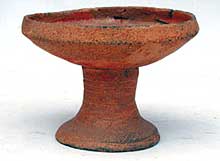Sa Huynh artifacts explain piece of the past
Update: Jul 16, 2009
Hundreds of objects displayed at the Vietnam Museum of History will inform people about an ancient culture that flourished 2,000-2,500 years ago.
 The museum has launched an exhibition featuring artifacts of the Sa Huynh Culture, on the occasion of the 100th anniversary of the culture’s discovery in Vietnam. The museum has launched an exhibition featuring artifacts of the Sa Huynh Culture, on the occasion of the 100th anniversary of the culture’s discovery in Vietnam.
The Sa Huynh Culture is the name given to the urn field (jar burial) culture of the coastal plains in central and southern Vietnam. Archaeological sites have been discovered from the Mekong Delta to just south of the Tonkin region.
Sa Huynh sites are rich in locally worked iron artifacts, typified by axes, swords, spearheads, knives and sickles.
The Sa Huynh cremated dead adults and buried them in jars covered with lids, a practice unique to the culture. Ritually broken offerings usually accompanied the jar burials.
The most typical style of burial of Sa Huynh Culture in the early Iron Age was in burial jars.
Burial jars of the Sa Huynh vary in measurement and type, but they are mostly cylindrical and egg-shaped with conical lids.
The culture is also typified by its unique ear ornaments featuring two-headed animals. The ornaments were commonly made from jade, but also from glass. Bead ornaments were also commonly found in Sa Huynh burials, most commonly made from glass, carnelian, agate, olivine and gold.
"The diversification of objects and the various types of Sa Huynh artifacts have surprised us. Our ancestors made great creations and left for us a heritage that is as huge and interesting as all other ancient civilisations in the world," said Pham Quoc Quan, director of the museum.
"After 100 years studying the culture we have seen remarkable results, but the number of things exhibited here is limited. There are holes among the artifacts here that need to be filled with new objects from recent and upcoming discoveries and excavations." said Quan.
The opening ceremony of the exhibition drew hundreds of experts, collectors and foreigners.
"I just arrived here by chance... but it’s really a golden opportunity for me to learn about one of the country’s ancient cultures," said Marie Johnsons, from the US.
"I’m not an expert, but I’m really interested in the artifacts displayed here, which are various and beautiful. It’s also the first time I’ve heard of these kinds of jars; it’s an amazing idea by the Vietnamese," she said.
The display is organised in co-ordination with the Institute of Archaeology and the Museum of Anthropology.
An earthenware coffin found in the Sa Huynh salt marsh in Duc Pho District,
Quang Ngai Province, in 1909 by a French scientist, was the first landmark of the culture’s discovery. So far, about 80 relic sites related to the Sa Huynh Culture have been found.
VNA
|
 |
|